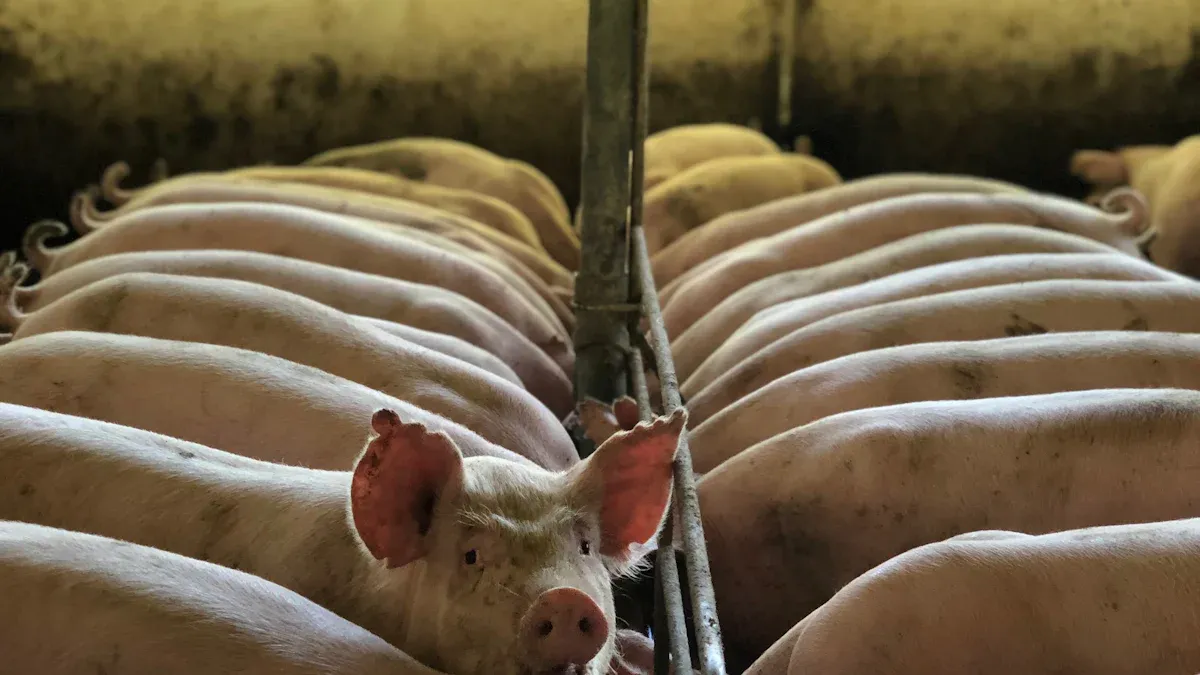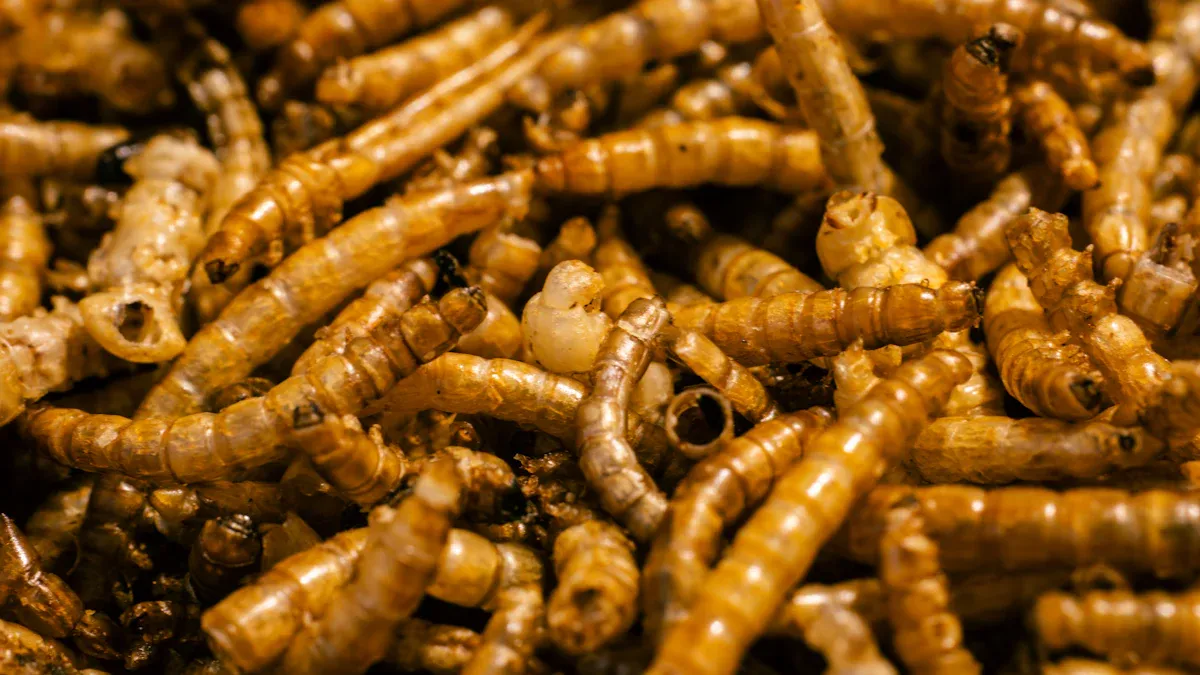
German livestock producers are turning to premium mealworm animal feed for its exceptional benefits. Packed with protein (31.19%–47.34% dry matter) and essential minerals like phosphorus and magnesium, mealworms meet EU standards for high-nutrition claims. They also require less land and water than traditional feed, making them a sustainable choice for modern farming.
Key Takeaways
- Mealworm feed is full of protein and nutrients. It helps animals stay healthy and grow better. It can boost milk, weight, and egg production.
- Using mealworm feed is better for the environment. It needs less land and water. It also makes fewer harmful gases than regular feed.
- Farmers can spend less money on feed and earn more. Mealworm feed works better, so animals need less of it to grow. This makes it a smart and affordable option.
Nutritional Benefits of Mealworm Animal Feed

Protein and Essential Nutrients
Mealworm animal feed is packed with essential nutrients that livestock need to thrive. One of its standout features is its high protein content, which varies depending on the feed type. For example, studies show that mealworms fed on potato cuttings have significantly higher protein and fat levels compared to other feed types. This makes them an excellent source of energy and growth for livestock.
Mealworms also contain a rich array of minerals, including phosphorus, magnesium, potassium, zinc, and manganese. These minerals play a vital role in maintaining strong bones, boosting immunity, and supporting overall health. According to research, mealworms meet EU standards for high protein, low saturated fat, and high fiber, making them a superior choice for livestock nutrition.
| Nutritional Aspect | Findings |
|---|---|
| Protein Content | Increased significantly with potato cuttings |
| Fat Content | Doubled when fed potato cuttings |
| Mineral Content | Rich in phosphorus, magnesium, potassium, zinc, and manganese |
Impact on Livestock Health and Productivity
Feeding livestock with mealworm animal feed can lead to noticeable improvements in their health and productivity. The feed is rich in B vitamins, which are essential for energy metabolism and overall well-being. It also contains iron, which supports oxygen transport and energy production, and zinc, which enhances immune function and growth.
Mealworms also promote better digestion and nutrient absorption, thanks to their positive impact on gut health. Livestock fed with mealworms often show reduced inflammation, leading to fewer health issues and better performance. These benefits translate into higher productivity, whether it’s increased milk yield, faster weight gain, or improved egg production.
- Key benefits of mealworm feed for livestock:
- Boosts energy and metabolism with B vitamins.
- Strengthens immunity and growth with zinc.
- Improves digestion and reduces inflammation for better health outcomes.
By incorporating mealworm animal feed into their diets, German livestock producers can ensure healthier animals and more efficient farming operations.
Sustainability of Mealworm Animal Feed

Environmental Advantages
Mealworm animal feed offers remarkable environmental benefits compared to traditional protein sources. Its production requires fewer resources, such as land and water, making it a sustainable choice for modern agriculture. Unlike conventional livestock farming, which demands vast amounts of arable land, mealworms can be farmed vertically. This innovative approach significantly reduces space requirements.
Additionally, mealworms produce far fewer greenhouse gases and ammonia emissions than cattle or pigs. For instance, studies show that mealworm farming emits substantially less carbon dioxide and ammonia, contributing to cleaner air and a healthier environment. The table below highlights the sustainability of mealworm production compared to conventional protein sources:
| Aspect | Mealworm Production | Conventional Protein Sources |
|---|---|---|
| Greenhouse Gas Emissions | Lower | Higher |
| Ammonia Emissions | Lower | Higher |
| Water Requirement | Less | More |
| Space Requirement | Less (vertical farming) | More |
Reducing the Agricultural Carbon Footprint
Switching to mealworm animal feed can drastically reduce the carbon footprint of agriculture. Mealworms emit significantly less carbon dioxide per kilogram of protein compared to beef, pork, or chicken. For example, beef production generates about ten times more greenhouse gases than mealworms. The following table illustrates the greenhouse gas emissions of various protein sources:
| Protein Source | Greenhouse Gas Emissions (CO2-eq per kg) |
|---|---|
| Mealworms | Low |
| Chicken | Slightly higher than mealworms |
| Pork | 10-100 times more than mealworms |
| Beef | About ten times more than mealworms |
| Milk | About half as much as mealworms |
By adopting mealworm feed, German livestock producers can play a vital role in combating climate change. This sustainable alternative not only reduces emissions but also promotes resource efficiency, paving the way for a greener future.
Cost-Effectiveness of Mealworm Animal Feed
Economic Benefits for Farmers
Mealworm animal feed offers significant economic advantages for farmers. Its high nutritional value and growing popularity have positioned it as a promising alternative to traditional protein sources. The global mealworm market is projected to reach $1.27 billion by 2030, with the animal feed segment leading the way. This growth reflects the increasing demand for sustainable and nutrient-rich feed options.
Farmers using mealworms can reduce their reliance on costly feed ingredients like soybean and fishmeal. A case study on small-scale poultry farmers in South Africa revealed that incorporating mealworm feed lowered feed costs and boosted income. Many farmers even expressed interest in rearing mealworms themselves, further cutting expenses. However, the current market price of mealworm meal remains a challenge compared to conventional feeds.
Despite this, the long-term benefits outweigh the initial costs. Mealworms’ superior nutritional profile leads to healthier livestock, which translates to higher productivity and profitability. For farmers, this means better returns on investment and a more sustainable farming model.
Feed Conversion Efficiency
Mealworm feed also excels in feed conversion efficiency (FCR), a critical metric for evaluating feed performance. FCR measures how effectively animals convert feed into body mass. Compared to traditional feeds, mealworms demonstrate impressive efficiency, especially in high-protein, high-fat diets.
| Metric | Mealworm FCR | Traditional FCR |
|---|---|---|
| Poultry Meat | > 3.8 | 2.3 |
| Pork | > 3.8 | 4.0 |
| Cereal Beef | > 3.8 | 8.8 |
| Carrot-Supplemented Diet (High Protein, High Fat) | 1.8 | N/A |
| Commercially Produced Mealworms | 2.2 | N/A |
These numbers highlight mealworms’ potential to outperform traditional feeds in certain scenarios. For example, carrot-supplemented mealworm diets achieve an FCR as low as 1.8, showcasing their efficiency in converting feed into animal growth. This efficiency not only reduces feed costs but also minimizes waste, making mealworms a cost-effective and environmentally friendly choice for livestock producers.
Comparison with Traditional Feed Options
Nutritional Superiority
Mealworm animal feed stands out for its exceptional nutritional profile compared to traditional feed options. It offers high protein content, low saturated fat, and high fiber, meeting EU standards for superior nutrition. For instance, yellow mealworm larvae qualify as “high protein” and “low saturated fat” on both fresh and dry matter bases. They are also rich in essential minerals like phosphorus, magnesium, potassium, zinc, and manganese, which are vital for livestock health.
A comparative study highlights the differences in fatty acid composition. Mealworms fed with potato cuttings showed higher concentrations of saturated and mono-unsaturated fatty acids, while traditional feeds had more poly-unsaturated fatty acids. This unique balance makes mealworms an excellent energy source for livestock.
| Nutritional Aspect | Mealworm (Dry Matter) | Traditional Feed Comparison |
|---|---|---|
| Protein Content | High | High Protein Claims |
| Saturated Fat | Low | Low Saturated Fat Claims |
| Fiber Content | High | High Fiber Claims |
| Mineral Content | Rich in P, Mg, K, Zn, Mn | Regulation (EU) Standards |
Sustainability and Environmental Impact
Mealworm feed is a game-changer for sustainable farming. It requires less land, water, and food compared to traditional livestock feed. Vertical farming systems make mealworm production space-efficient, while their lower greenhouse gas emissions contribute to a cleaner environment.
Insect rearing, including mealworms, produces significantly less ammonia and greenhouse gases than conventional livestock farming. For example, mealworms emit far fewer emissions than cattle or pigs. This makes them an eco-friendly alternative for reducing agriculture’s environmental footprint.
| Aspect | Mealworm Feed | Traditional Livestock |
|---|---|---|
| Land Requirement | Lower | Higher |
| Water Requirement | Lower | Higher |
| Food Requirement | Lower | Higher |
| Greenhouse Gas Emissions | Fewer | More |
Cost Analysis
While mealworm feed may have a higher upfront cost, its long-term benefits outweigh the initial investment. Its superior feed conversion efficiency (FCR) means less feed is needed to achieve the same growth in livestock. This reduces overall feed expenses over time.
Farmers can also save on resources like water and land, which are more expensive with traditional feed options. Additionally, the growing demand for sustainable farming practices positions mealworm feed as a future-proof investment. By switching to mealworms, farmers can achieve better profitability while supporting environmentally responsible agriculture.
Practical Implementation for German Livestock Producers
Integrating Mealworms into Livestock Diets
Introducing mealworms into livestock diets is easier than it might seem. Farmers can start by gradually mixing mealworms with existing feed. This helps animals adjust to the new diet without any digestive issues. For example, poultry and pigs can benefit from a blend of mealworms and grains, while cattle may thrive on a mix of mealworms and silage.
Mealworms can be used in various forms, such as dried, powdered, or whole. Each form has its advantages. Dried mealworms are easy to store and handle, while powdered mealworms can be mixed seamlessly into feed. Whole mealworms, on the other hand, are ideal for animals that enjoy foraging. Farmers should choose the form that best suits their livestock’s needs.
It’s also important to monitor the animals’ response. Farmers can track weight gain, milk production, or egg yield to ensure the diet is working effectively. Adjustments can be made based on these observations. With proper integration, mealworm animal feed can become a staple in livestock diets, boosting both health and productivity.
Sourcing Premium Mealworm Animal Feed
Finding high-quality mealworm feed is crucial for success. Farmers should look for suppliers that meet EU standards for safety and nutrition. Many reputable companies now specialize in producing mealworms for animal feed. These suppliers often provide detailed information about the nutritional content and farming practices used.
Local sourcing can be a great option for reducing costs and supporting sustainable practices. Some farmers even choose to rear mealworms themselves. This approach requires an initial investment in equipment and knowledge but can lead to long-term savings.
When sourcing mealworm feed, it’s essential to compare prices, quality, and delivery options. Farmers should also consider the supplier’s reputation and customer reviews. By choosing the right source, German livestock producers can ensure they’re providing their animals with the best possible nutrition.
Premium mealworms are revolutionizing livestock farming in Germany. They deliver unmatched nutrition, eco-friendly benefits, and cost savings. Farmers adopting mealworms can expect healthier animals, reduced environmental impact, and better profits.
🐛 Tip: Switching to mealworm feed isn’t just smart—it’s a step toward sustainable and profitable farming for the future.
FAQ
What makes mealworm feed better than traditional livestock feed?
Mealworm feed offers higher protein, essential nutrients, and better sustainability. It requires less land and water while reducing greenhouse gas emissions. 🐛🌱
Can mealworms be used for all types of livestock?
Yes, mealworms suit poultry, pigs, and cattle. Farmers can adjust the form—dried, powdered, or whole—based on their livestock’s needs.
Is mealworm feed safe for livestock?
Absolutely! Mealworm feed meets EU safety and nutrition standards. Farmers can confidently use it to improve livestock health and productivity. ✅
💡 Tip: Start small when introducing mealworms into diets. Gradual changes help livestock adjust smoothly.


